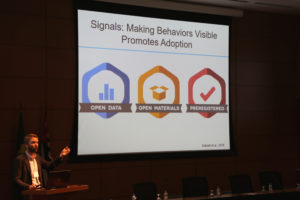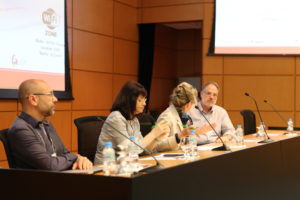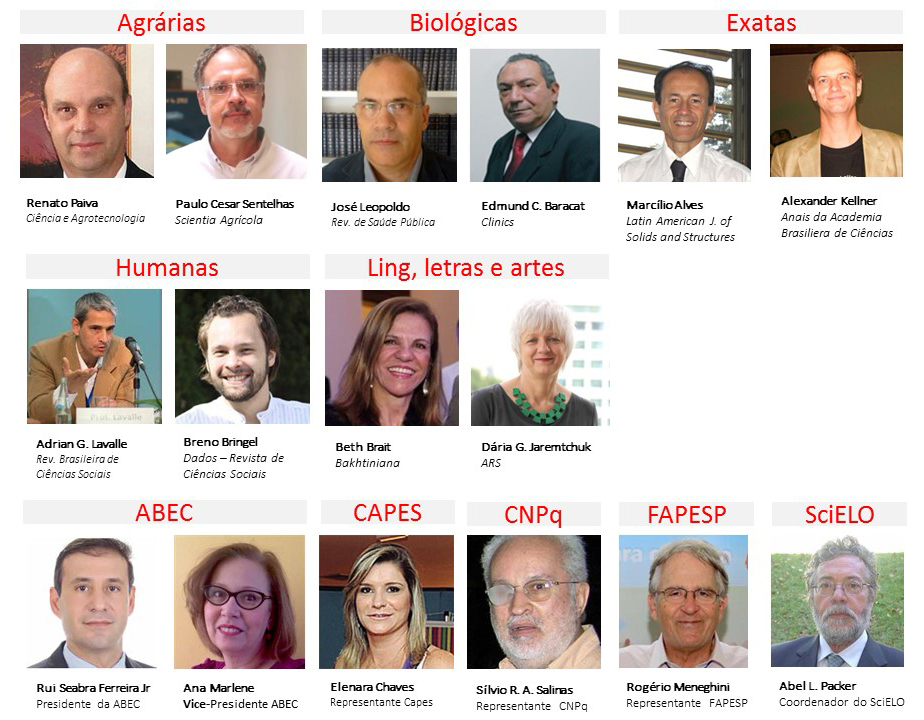By Abel L. Packer, Denise Peres Sales, Solange Santos, Alex Mendonça, Rogério Meneghini
The Criteria, policy and procedures for the admission and permanence of journals in the SciELO Brazil Collection1 were updated and become valid from January 2018. The new version contemplates advances in editorial policies related to the alignment of the SciELO Program with good practices of open science research communication. The perspective is to reinforce the contribution of SciELO journals in the social and scientific qualification of Brazilian research2. The criteria aim to increase transparency, completeness, celerity and interoperability of research communication. Those were subjects widely discussed in the two panels of the VII SciELO Annual Meeting3, both of which had the active participation of SciELO indexed journals. The first panel focused on the current and future status of SciELO and the second focused on the alignment of SciELO with open science.
| Pannel about the impact dimensions of SciELO Brazil journals | |||
 |
 |
 |
 |
| Maria José Tonelli Chair |
Paula Beatriz de Araujo  |
Paulo Cesar Sentelhas |
Rodrigo Firmino |
| Pannel about the alignment of SciELO with Open Science | |||
 |
 |
 |
 |
| Marta Teresa da Silva Arretche Chair |
Claude Pirmez |
Luciene Stamato Delazari |
Moisés Goldbaum |
The advances in the SciELO Brazil Criteria, discussed at the VII Annual Meeting and synthesized herein, contemplate adopting the following editorial policies and practices:
- ORCID as the sole authors’ identifier
ORCID (Open Researcher and Contributor ID) is a unique researcher identifier and should be an integral part of the authors’ institutional affiliation. Starting 2019, the presence of ORCID in the authors’ affiliation will be obligatory. However, journals should begin collecting the ORCID ID as soon as possible, even if optional, in order to master the registration process, proper presentation and affiliation marking.
ORCID will contribute to the authors’ accurate identification by distinguishing homonyms and maximizing interoperability options. The authors’ ORCID record operates as a profile or curriculum of the researchers that adds value to the bibliographic references. The ORCID website provides a programming interface so that the SciELO portal will link to the authors’ records. Until recently, SciELO was linking Brazil’s authors with the Lattes curriculum, but the service was not automated and was discontinued. ORCID will extend the link to the authors’ names regardless of the country of affiliation.
The ORCID ID must be collected in the submission form and it is expected that the manuscript management systems immediately validate the entered identifier. The Clarivate Analytics ScholarOne system, used by 48% of the SciELO Brazil journals, and version 3.0 of the Open Journal Systems (OJS) of the Public Knowledge Project (PKP), used by 40% of the SciELO Brazil journals already offer an ORCID validation option.
In the near future, SciELO will promote the retroactive assignment of ORCID IDs to authors’ previously published articles whenever an accurate identification of the authors is possible.
- Preprints for transparency, quality and fast communication
Following the international trend, the SciELO Program adopted preprints as one of the main advances in its alignment with open science research communication. The SciELO Preprints server was announced in February 20174 and its operation is scheduled to start in July 2018.
In this sense, SciELO journals should progressively define their policies regarding the assessment of previously deposited manuscripts on recognized preprints servers, including SciELO Preprints. To do so, they should detail this editorial policy in the instructions to authors section. It is expected that all SciELO journals will have taken a stand regarding this policy in the next three years, a period considered sufficient for the evolution of preprints and its function in the flow of scientific communication to be consolidated for the communities of editors and authors, as well as funding agencies authorities.
In a pioneering decision, the Editor-in-Chief of Memórias do Instituto Oswaldo Cruz announced in December 20175 that the journal began accepting manuscripts already made available as preprints. This decision, coming from the oldest and most cited SciELO Journal, represents a remarkable support for the dissemination of preprints.
Preprints are manuscripts that are ready to be submitted to a journal, but are pre-deposited on a preprints server and made available for public access. Preprints are provided with a DOI number assigned by the preprints server and made available in open access with a Creative Commons license defined by the authors.
Authors can submit a preprint to a journal immediately after posting it to a server or wait for some time during which they can update it taking into account comments and suggestions from colleagues and readers. A preprint submitted to a journal may or may not get accepted. If accepted, the journal assigns a new DOI and its access policy to the article. It should be noted that an open access preprint may eventually be submitted and approved by a restricted access journal, i.e., the preprint will remain in open access, but the final article might have access restrictions imposed by the journal. However, the expectation is that open access publications predominate, particularly when it is a SciELO journal. When the manuscript is not approved, authors may submit it to another journal.
The adoption of preprints will speed up research communication, while ensuring the corresponding authorship of research results, of either new discoveries and proposals or improvements of processes and advances. The preprints have been used in physics for more than 20 years through the arXiv server and last year the adoption of preprints has been consolidated in biological sciences with bioRxiv. SciELO Preprints will use the Open Science Framework (OSF) platform of the Center for Open Science (COS).
One of the critical aspects in the implementation and development of SciELO Preprints is the establishment of prompt quality control mechanisms to ensure that the deposited texts are of scientific nature and ready to be submitted to a journal. Since preprints do not undergo peer review, the responsibility for the quality of the deposited texts is solely the authors’. Careful preparation of manuscripts becomes essential considering that preprints remain forever available together with the different versions generated. There is a large volume of low quality manuscripts currently being submitted to SciELO journals and being rejected because they don’t meet the minimum criteria for assessment. There is the perspective that transferring the control of the public availability of the manuscripts to the authors will make them extra cautious when preparing and evaluating the manuscripts, leading to a progressive improvement of the deposited manuscripts. Moreover, as stated above, manuscripts can be further improved by exposing them to comments before the submission to a journal.
SciELO Preprints will organize the reception and moderation of preprints by thematic areas with the support of SciELO journal’s editors, particularly in defining the criteria for identifying scientific manuscripts suitable for submission to journals.
Internationally, the management of preprints in scholarly communication flows, particularly quality control, indexing and citation counting should be improved in the forthcoming years as the use of preprints generalizes.
- Referencing research materials for transparency and reproducibility
The sources of data, materials, methods and computer software code used in the design, implementation and communication of research projects, which are often underlining in the texts of the articles that communicate the results, should be progressively disclosed and referenced according to general standards according to the thematic areas.
The disclosure and referencing aim to reinforce and increase the transparency, reproducibility, visibility and interoperability of research. To this end, the SciELO Program adopted COS’ Transparency and Openness Promotion (TOP) Guidelines6, which establishes eight criteria on how articles should inform about the level of openness, transparency and reproducibility of the research they communicate. Each of the eight criteria can be implemented progressively and modularly at three levels of application, beginning by disclosing, followed by requiring and verifying. In summary the eight criteria and their three levels of deployment are as follows:
- The standards for citation of data, materials, methods and computer software code adopted by the journal and that should be informed in the instructions to authors section. This criterion extends the adoption of the citation standard of texts to cover the other components. The first level of implantation of the criterion consists in the documentation of the norms in the instructions to authors section, the second in the requirement of application of the norms, and the third restricts the publication only to articles that follow the norms.
- The indication of transparency of the availability of the following three components of the research projects: data, research materials and computer software. There are three distinct criteria, but they follow similar referencing processes. Journals may adopt the same or different levels of implementation for each criterion. In the first level, the article should indicate whether the components are available and if so, how to access them, in the second, the components must be available in a reliable repository with the exceptions informed at the time of manuscript submission and, in the third, all components must be accessible to the journal and the publication of the article will be conditioned to the verification of the replicability of the results.
- The transparency of the research design and analyses related to the data, materials and code whose availability and access have been informed in the three previous criteria. This criterion is highly dependent on the thematic area of the research. At the first level of implementation, the paper documents standards and guidelines for research design and analysis of recommended data; in the second, authors report on the review and application of standards and guidelines, and, in the third, the publication of the article will be conditioned to the verification of compliance to standards and guidelines.
- The pre-registration of the study, or more specifically, the data analysis plan that defines whether the research is exploratory or confirmatory. These are two criteria, but the occurrence of the second replaces the first. Pre-registration also contributes to the identification of research that is not published. In the first level, the journal specifies its policy regarding the previous registration of research and/or analysis plans; in the second, the author indicates at the submission the link to the record and the journal verifies its validity, and, third, the publication of the articles will be subject to prior registration.
- The eighth criterion deals with the conditions of reproducibility of the research and is oriented to the journals. At the first level, the journal stimulates the submission of reproducibility studies especially of the researches it publishes. In the second level, the journal evaluates the studies at two occasions: the proposal and, if approved, the manuscript with the results. At the third level, the publication of previous reports of the reproducibility study it is considered.
It is expected that SciELO Brazil will adopt level 1 of the criteria by middle 2019 and a good part of level 2 by the end of 2020, i.e., a sufficient period of time for journals to review their editorial policies and procedures. SciELO will promote in the next two years seminars and training for the adoption of referencing the materials used in research focusing on the specificities of each thematic area.
Members of the SciELO Brazil Advisory Committee, 2017-2018
A new stage in journals’ development
In many ways, the new SciELO Brazil Criteria project a new stage of improvement of Brazil’s scientific communication, which should be progressively extended to the other countries of the SciELO Network.
The advancement towards open science has as a characteristic the repositioning of the main actors of scholarly communication. On one hand, the repositioning of researchers, who now have more control over the communication process, as well as greater responsibility. By using preprints, authors are required to deposit very well-crafted manuscripts. By enriching and complementing the manuscripts with the availability and referencing of the materials that ground their research, the authors contribute to improve significantly the quality and reproducibility conditions of the results their articles communicate. The availability of the materials also increases the research visibility, since using data and other materials requires the citation of both those materials and the corresponding articles. There are also new tools oriented to the edition of the manuscripts that incorporate revision and publishing functions, according to different styles of text presentation.
On the other hand, there is the repositioning of journals, their editors and referees who are called to promote and ensure the transparency and completeness of the research communication and to exercise the key function of orienting researchers, initially, through instructions and comments, and later, conditioning the assessment of the manuscripts to transparency standards. By accepting the appraisal of manuscripts previously deposited as preprints, the journals privilege their research validation functions and are favored by the authors for the efficiency and quality of the peer review process and the dissemination and interoperability services supported by SciELO. By requiring manuscripts to be enriched by referencing and the availability of research materials, the journals will make a decisive contribution to the advancement of open science.
The SciELO Program adopted five years ago the priority lines of action to strengthen professionalism, internationalization and operational and financial sustainability, which were formally approved at the SciELO Network meeting on the occasion of the program’s fifteenth anniversary. In September 2018, for the celebration of the 20 years of SciELO, the update of the priority lines of action with the adoption of good practices of open science communication is foreseen.
Notes
1. Critérios, política e procedimentos para a admissão e a permanência de periódicos científicos a Coleção SciELO Brasil [online]. SciELO Brasil. 2017 [viewed 10 January 2018]. Available from: http://www.scielo.br/avaliacao/Criterios_SciELO_Brasil_versao_revisada_atualizada_outubro_20171206.pdf
2. PACKER, A.L. and MENEGHINI R. The time has come for the quality journals of Brazill [online]. SciELO in Perspective, 2017 [viewed 10 January 2018]. Available from: http://blog.scielo.org/en/2017/11/08/the-time-has-come-for-the-quality-journals-of-brazil/
3. Programa [online]. VII Reunião Anual SciELO. 2017 [viewed 10 January 2018]. Available from: http://eventos.scielo.org/viireuniaoscielo/programa/
4. PACKER, A.L., SANTOS, S. and MENEGHINI, R. SciELO Preprints on the way [online]. SciELO in Perspective, 2017 [viewed 10 January 2018]. Available from: http://blog.scielo.org/en/2017/02/22/scielo-preprints-on-the-way/
5. PIRMEZ, C. Towards open science, Memórias do Instituto Oswaldo Cruz welcome submission of preprint manuscripts [online]. SciELO in Perspective, 2017 [viewed 10 January 2018]. Available from: http://blog.scielo.org/en/2017/12/07/towards-open-science-memorias-do-instituto-oswaldo-cruz-welcome-submission-of-preprint-manuscripts/
6. Guidelines for Transparency and Openness Promotion (TOP) in Journal Policies and Practices “The TOP Guidelines” [online]. OSF. 2017 [viewed 10 January 2018]. Available from: https://osf.io/dngy3/
References
Critérios, política e procedimentos para a admissão e a permanência de periódicos científicos a Coleção SciELO Brasil [online]. SciELO Brasil. 2017 [viewed 10 January 2018]. Available from: http://www.scielo.br/avaliacao/Criterios_SciELO_Brasil_versao_revisada_atualizada_outubro_20171206.pdf
PACKER, A.L. and MENEGHINI R. The time has come for the quality journals of Brazill [online]. SciELO in Perspective, 2017 [viewed 10 January 2018]. Available from: http://blog.scielo.org/en/2017/11/08/the-time-has-come-for-the-quality-journals-of-brazil/
PACKER, A.L., SANTOS, S. and MENEGHINI, R. SciELO Preprints on the way [online]. SciELO in Perspective, 2017 [viewed 10 January 2018]. Available from: http://blog.scielo.org/en/2017/02/22/scielo-preprints-on-the-way/
PIRMEZ, C. Towards open science, Memórias do Instituto Oswaldo Cruz welcome submission of preprint manuscripts [online]. SciELO in Perspective, 2017 [viewed 10 January 2018]. Available from: http://blog.scielo.org/en/2017/12/07/towards-open-science-memorias-do-instituto-oswaldo-cruz-welcome-submission-of-preprint-manuscripts/
Programa [online]. VII Reunião Anual SciELO. 2017 [viewed 10 January 2018]. Available from: http://eventos.scielo.org/viireuniaoscielo/programa/
ZIEGLER, M.F. SciELO anuncia adoção de preprint em 2018. 2017 [viewed 10 January 2018]. Available from: http://agencia.fapesp.br/scielo_anuncia_adocao_de_ipreprint_i_em_2018/26896/
External links
BioRxiv <https://en.wikipedia.org/wiki/BioRxiv>
ORCID <https://en.wikipedia.org/wiki/ORCID>
OSF <https://en.wikipedia.org/wiki/Center_for_Open_Science#Open_Science_Framework>
Translated from the original in portuguese by Lilian Nassi-Calò.
Como citar este post [ISO 690/2010]:




















Recent Comments